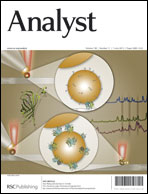Herein, a novel highly sensitive enhanced-fluorescence immunoassay for detection of superoxide dismutase (SOD) is established by combining surface-enhanced fluorescence (SEF) with immuno-magnetic separation. Based on a sandwich-type immunoassay, analytes in samples are first captured by magnetic beads coated with a monoclonal antibody and then “sandwiched” by another monoclonal antibody on silver nanoparticles labeled with fluorescein-labeled oligonucleotides in the presence of a magnet. Subsequently, the immune complex is enriched by exposure to a magnetic field. Lastly, the fluorescence intensity is measured according to the number of dissociated fluoresceins. The increased fluorescence intensity permits highly sensitive detection of SOD in a linear range of 10–8 × 105 pg mL−1, with a detection limit of 4 pg mL−1 at a signal-to-noise ratio of 3. Significantly, this method was validated for detection of SOD in human serum, human urine, and cosmetic samples. Moreover, the reliability and accuracy of results obtained by the enhanced-fluorescence method was confirmed by the analysis of high performance liquid chromatography (HPLC).

You have access to this article
 Please wait while we load your content...
Something went wrong. Try again?
Please wait while we load your content...
Something went wrong. Try again?


 Please wait while we load your content...
Please wait while we load your content...